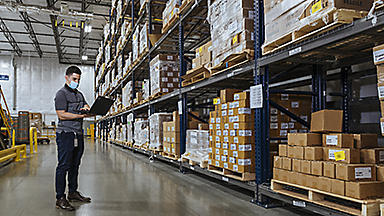4 Ways to Safeguard the Shipping Experience Against Weather Risks
4 Ways to Safeguard the Shipping Experience Against Weather Risks
With April being Earth Month and the start of hurricane season prep, it's crucial to begin implementing safeguards against the potential havoc climate risks can wreak on our supply chains.
When thinking about the tumultuous supply chain disruptions experienced in recent years, it's easy to point a finger at COVID-19’s shutdowns as the main cause. However, we can’t ignore the impact of extreme weather events, exacerbated by climate change, on global supply chains. In fact, the National Oceanic and Atmospheric Administration reported 2023 as the fifth warmest year on record with 28 weather and climate disasters, resulting in $92.9 billion of damage. From wildfires and floods to hurricanes and heat waves, these events have left their mark, affecting not only businesses but the shipping experience itself.
A report by UPS Capital revealed 75% of surveyed merchants have reported increased incidences of damaged, expired, or lost packages due to severe weather events, which is alarming considering the slow-moving climate change crisis that is poised to intensify in the upcoming years. Subsequently, 92% of surveyed merchants anticipate further shipping and delivery challenges attributable to climate change over the next five years.
With April being Earth Month and the start of hurricane season prep, it's crucial to begin implementing safeguards against the potential havoc climate risks can wreak on our supply chains.

Protecting Warehouse Inventory
Warehouses, filled with millions of dollars’ worth of inventory, stand vulnerable to climate-related risks like fires and floods. The US Census Bureau estimates inventory stockpiles exceeded $2.5 billion at the beginning of 2024, making it imperative for companies to shield against potential losses. In high-risk areas like California and Florida, where natural disasters tend to be more common, the need for protective measures becomes even more urgent. Moreover, many insurance policies may only offer limited coverage for inventory at rest, leaving merchants exposed to significant financial risks in the event of a catastrophe.
Circumventing Shipping Delays
Climate change has transformed severe weather into a global challenge, leading to port shutdowns, longer freight routes, and last-mile delays. Therefore, relying on a single supply chain line leaves businesses susceptible to weather-induced disruptions. For instance, recent droughts have triggered supply chain woes along major trade waterways like the Panama Canal, causing worldwide shipment delays. Diversifying supply sources mitigates risks and helps to ensure a steady flow of inventory even in the face of logistical hurdles.
Investing in Weather-Stabilizing Shipment Packaging
Customers now expect additional measures to safeguard their orders from weather-related issues. As a result, merchants must invest in precautionary measures such as weather-stabilizing shipment packaging to protect sensitive items like electronics and pharmaceuticals. From express shipping to insulated containers, these solutions protect packages from extreme temperatures and elements, preserving their integrity throughout the shipping process.
Understanding the Need for Shipping Insurance
With climate disasters on the rise, it's crucial for businesses to prioritize proper shipping insurance. By investing in comprehensive coverage like InsureShield® shipping insurance, merchants can minimize financial losses and enhance the customer experience. Swift resolution of shipping issues not only fosters customer satisfaction but also bolsters the resilience of businesses in the face of climate-induced disruptions.
As we navigate the complexities of today's supply chains, it's imperative to recognize and address the risks posed by extreme weather. By implementing robust safeguards and investing in proactive measures, businesses can weather the storm and emerge stronger in an increasingly volatile environment.
Additional Resources

Insights to Help Your Business
How Merchants Can Safeguard Themselves from Fraud and Counterfeit Goods
Strategies and tools to combat return fraud and counterfeiting.










































